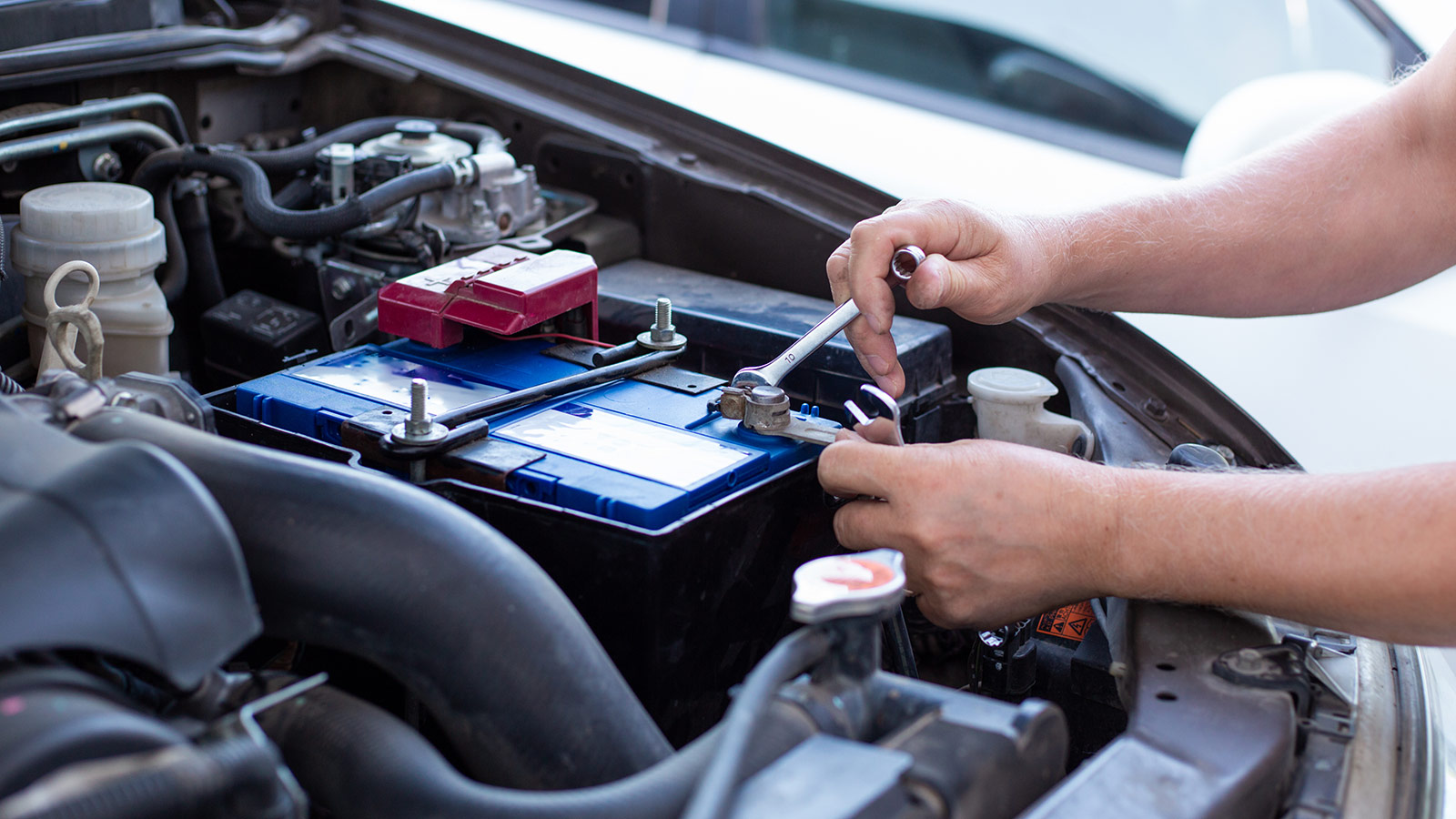Replacing a car battery is a common task for vehicle owners. It ensures your car runs smoothly and reliably.
Every car battery has a limited lifespan. Over time, it weakens and needs replacement. Knowing how to replace it can save you time and money. This guide will help you understand when and how to change your car battery. It’s simpler than you might think.
Plus, doing it yourself gives you confidence and peace of mind. Ready to learn more? Let’s dive into the steps and tips for replacing your car battery efficiently.

Credit: www.homedepot.com
Choosing The Right Battery
Choosing the right car battery is crucial for your vehicle’s performance. A good battery ensures smooth starts and reliable power. Making the right choice can save time and money. Let’s explore the key factors to consider when selecting a battery.
Battery Types
There are several types of car batteries. Lead-acid batteries are common. They are affordable and reliable. Another type is the AGM battery. It offers better performance and lasts longer. Lithium-ion batteries are lightweight and efficient. Each type has its pros and cons. Consider your needs and budget.
Compatibility Check
Ensure the battery fits your car. Check your car’s manual for specifications. Look at the battery size and type. The battery should match the car’s electrical system. Incorrect batteries can cause damage. Always double-check before purchasing.

Credit: auto.howstuffworks.com
Essential Tools And Supplies
Replacing a car battery is a task you can handle with the right tools and supplies. Knowing what you need makes the job easier and safer. This section will guide you through the essential tools and supplies required for replacing your car battery.
Tool List
First, gather the necessary tools. A set of wrenches is essential. You will need both metric and standard sizes. A socket set can also be helpful. Make sure to have a battery terminal puller. This tool helps remove the old battery without damaging the terminals. A wire brush is useful for cleaning the battery terminals. Corrosion can build up, so keep the terminals clean. You will also need a battery terminal cleaner. It helps ensure a good connection for the new battery. Finally, a battery carrier or strap is vital. Batteries are heavy and awkward to carry. The strap makes it easier and safer.
Safety Gear
Safety should always be a priority. Wear protective gloves to prevent acid burns. Battery acid is harmful and can cause serious injury. Safety glasses are also important. They protect your eyes from acid splashes. Work in a well-ventilated area. Battery fumes can be harmful if inhaled. Ensure you have a fire extinguisher nearby. In case of sparks or fire, quick action is crucial. Always disconnect the negative terminal first. It prevents accidental short circuits. Follow these safety measures to ensure a safe battery replacement process.
Preparing Your Vehicle
Replacing your car battery is a vital task to ensure your vehicle runs smoothly. Proper preparation is key to completing this task safely and efficiently. This section will guide you through the necessary steps to prepare your vehicle for a battery replacement.
Parking And Engine Off
First, park your vehicle on a flat surface. This ensures safety and stability. Engage the parking brake to prevent any movement. Turn off the engine completely. Remove the keys from the ignition. This step is crucial to avoid any electrical shock or short circuits.
Disconnecting The Old Battery
Before disconnecting, gather the necessary tools. You will need a wrench or socket set. Start by disconnecting the negative terminal first. This is usually marked with a minus (-) sign or black color. Loosen the nut with your wrench and gently lift the cable off the terminal. Secure the cable away from the battery.
Next, disconnect the positive terminal. It is marked with a plus (+) sign or red color. Again, loosen the nut and lift the cable off the terminal. Ensure both cables are secured away from the battery.
Some vehicles have a battery hold-down clamp. If so, use your wrench to remove it. Carefully lift the old battery out of the battery tray. Batteries are heavy, so use proper lifting techniques to avoid injury.
Now your vehicle is ready for the new battery installation. Follow these steps carefully to ensure a safe and efficient battery replacement process.
| Step | Action |
|---|---|
| 1 | Park on a flat surface and engage the parking brake. |
| 2 | Turn off the engine and remove the keys. |
| 3 | Disconnect the negative terminal first. |
| 4 | Disconnect the positive terminal. |
| 5 | Remove any battery hold-down clamp. |
| 6 | Lift the old battery out carefully. |
Removing The Old Battery
Replacing a car battery can seem daunting, but it’s simpler than you think. The first step is removing the old battery. Follow these steps to ensure a smooth process.
Battery Terminal Removal
Start by opening the car hood. Locate the car battery. It is usually a rectangular box with two cables attached. The terminals are marked with a plus (+) and minus (-) sign. Disconnect the negative terminal first. This prevents any electrical shorts. Use a wrench to loosen the nut on the negative terminal. Twist and pull the terminal off the battery post. Repeat this process for the positive terminal. Ensure both cables are secured away from the battery.
Lifting Out The Old Battery
Once the terminals are off, you can lift the old battery out. Most batteries are held in place by a clamp or bracket. Use a wrench to remove the bolts holding the clamp. Carefully lift the battery out of the tray. Car batteries are heavy and contain acid, so handle with care. Place the old battery in a sturdy container. This prevents any spills or damage.
Installing The New Battery
Replacing a car battery can seem daunting. It is a simple process. Follow these steps to install the new battery. Ensure you have the right tools and safety gear.
Placing The New Battery
Begin by placing the new battery in the battery tray. Make sure it sits securely. Check the battery hold-down clamp. It should be tight to prevent movement. An unsecured battery can cause damage.
Align the battery terminals. Positive to positive, negative to negative. Double-check the battery orientation. This prevents connection errors. Ensure the battery is level. This helps it perform better.
Connecting The Terminals
Start with the positive terminal. Attach the positive cable first. Use a wrench to tighten the clamp. Ensure it is snug but not too tight. Over-tightening can damage the terminal.
Next, connect the negative terminal. Tighten the clamp just like the positive. This completes the electrical circuit. Ensure both connections are secure. Loose connections can cause electrical problems.
| Step | Action | Details |
|---|---|---|
| 1 | Place New Battery | Ensure battery is secure in the tray |
| 2 | Connect Positive Terminal | Tighten the positive cable clamp |
| 3 | Connect Negative Terminal | Tighten the negative cable clamp |
Check the battery connections. Ensure they are tight and secure. This ensures the car will start properly. Your new battery is now installed and ready for use.

Credit: www.wyotech.edu
Securing The Battery
Securing the battery in your car is a crucial step. This ensures a stable power supply and prevents potential damage. Properly securing the battery helps to avoid electrical issues and prolongs battery life. Let’s dive into the steps involved.
Tightening Clamps
First, make sure the battery is properly aligned. Place it in the designated tray. The clamps should be tightened securely. Use a wrench to tighten the bolts. Ensure the clamps grip the battery terminals firmly. Loose clamps can cause connection issues. Tighten until the battery feels stable but avoid overtightening.
Ensuring Stability
Next, check the battery for movement. Gently try to move it. If it shifts, it needs further securing. Use a battery hold-down kit if necessary. This kit can provide added stability. A stable battery minimizes vibration damage. It also ensures a consistent power connection. Double-check all connections before finishing.
Testing The New Battery
After installing a new car battery, it’s essential to test it. This ensures the battery works well and all systems function properly. Let’s explore the steps to check your new battery.
Starting The Engine
Start the engine and listen carefully. The engine should start quickly and smoothly. If it struggles, the battery might not be fully charged. Watch for any unusual sounds or delays.
Checking Electrical Systems
Once the engine is running, check the car’s electrical systems. Turn on the headlights, wipers, and radio. Each system should operate normally.
- Headlights should be bright.
- Wipers should move smoothly.
- Radio should sound clear.
If any system doesn’t work well, the battery might be weak. Check the battery connections and try again.
Ensuring the new battery functions well is crucial for a reliable car.
Proper Disposal Of Old Battery
Replacing your car battery involves more than just installing a new one. You also need to properly dispose of the old battery. This step is crucial for protecting the environment and ensuring safety. Let’s explore the best ways to dispose of your old car battery.
Recycling Options
Recycling your old car battery is the best option. Most parts of a car battery can be recycled. Here are some recycling options:
- Auto Parts Stores: Many auto parts stores offer battery recycling. They may even give you a discount on your new battery purchase.
- Recycling Centers: Local recycling centers accept old car batteries. They ensure the batteries are properly handled and recycled.
- Car Dealerships: Some car dealerships accept old batteries when you buy a new one. Ask about their recycling programs.
Choose any of these options to recycle your old car battery. It helps keep our environment clean.
Environmental Considerations
Old car batteries contain harmful chemicals. These can damage the environment if not disposed of properly. Here are some key environmental considerations:
| Component | Environmental Impact |
|---|---|
| Lead | Can contaminate soil and water. |
| Acid | Can cause burns and pollute water sources. |
| Plastic | Not biodegradable, adds to landfill waste. |
Proper disposal ensures these harmful substances do not damage our planet. Always recycle your old car battery. It’s a small step with a big impact.
Frequently Asked Questions
How Do I Know If My Car Battery Needs Replacing?
Check for signs like dim headlights, slow engine crank, or frequent jump starts.
How Long Do Car Batteries Usually Last?
Car batteries typically last 3 to 5 years, depending on usage and climate.
What Tools Are Needed To Replace A Car Battery?
You’ll need gloves, safety glasses, a wrench, and a new battery.
Can I Replace A Car Battery Myself?
Yes, you can. Follow the steps carefully and take safety precautions.
What Should I Do With The Old Car Battery?
Recycle it at an auto parts store or recycling center. It’s environmentally friendly.
Conclusion
Replacing your car battery is simple and important. It keeps your car running smoothly. Follow the steps in this guide to ensure success. Always use the correct tools and safety gear. Regularly check your battery for signs of wear. Remember, a healthy battery means a reliable car.
With these tips, enjoy worry-free driving.

















